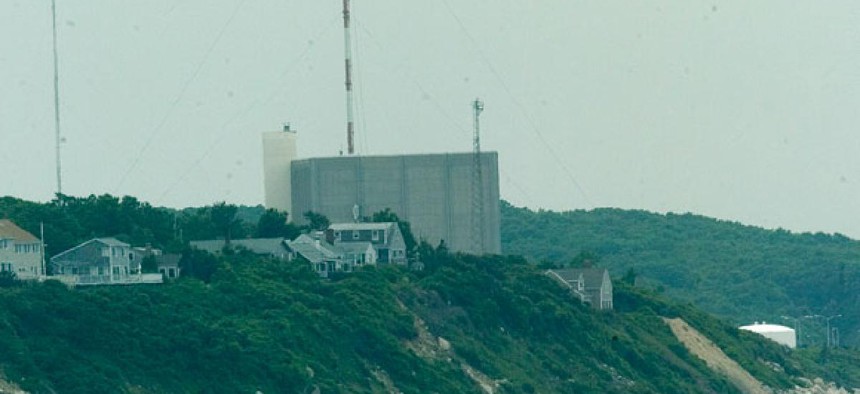NRC: New Nuclear Plant Safety Measures Not Premature But Final Decision Pending

The Pilgrim Station nuclear power plant in Plymouth, Mass., is one of the aging facilities. AP file photo
In the wake of the 2011 Fukushima Daiichi nuclear plant meltdowns in Japan, the commission has identified a host of potential ways to improve the security and safety of U.S. reactors
The Nuclear Regulatory Commission has rejected the notion that it is not ready to decide whether aging atomic power plants need to make upgrades intended to limit radiation releases during a major crisis, but its ultimate action on the matter is not yet clear.
In the wake of the 2011 Fukushima Daiichi nuclear plant meltdowns in Japan, the commission has identified a host of potential ways to improve the security and safety of U.S. reactors. It has divided those potential measures into tiers, identifying some as requiring action sooner and others further down the road.
Some Democrats and watchdog groups have suggested that the agency has not moved quickly enough to act on potential improvements. In a Friday letter, Senate Environment and Public Works Committee Chairwoman Barbara Boxer (D-Calif.) noted that today it two year anniversary of the onset of the Japanese crisis and that NRC staff issued a report on post-Fukushima recommendations in July 2011. Boxer asked commission Chairwoman Allison Macfarlane for provide a status update in advance of a hearing next month.
Republicans lawmakers have suggested, however, that the commission should not address its post-Fukushima response in a piecemeal fashion. Nor should it issue any major new requirements before conducting a thorough comparison of the Japanese and U.S. regulatory systems and devising a comprehensive plan for how to fill any potential gaps that could exacerbate a terrorist attack or natural disaster affecting a nuclear reactor.
During a recent hearing, Representative Edward Whitfield (R-Ky.) suggested that various safety and security issues that have arisen since the Fukushima incident “seem so interdependent." He questioned why the commission appeared to be making efforts to address them “independently and separate” from one another.
Specifically, Whitfield and other House Republicans have suggested that the commission should not require aging nuclear plants to install filtered vents until it completes the regulatory comparison and post-Fukushima reactor safety plan. Agency staff, along with many Democrats and watchdog groups, say filtered vents would limit radiation releases in the event of a terrorist attack or natural disaster. Should a facility lose power, vents relieve pressure building inside a heating reactor core while filters would reduce the amount of radiation that passes through the vents.
In response to Whitfield’s concerns, all five presidentially appointed commissioners said they were taking a comprehensive look at how requiring filtered vents and other possible post-Fukushima actions could impact one another, but suggested it would not be prudent to delay certain actions deemed to be the most pressing.
Republican Commissioner Kristine Svinicki suggested that if the agency did not dispose of some issues, it would create a state of perpetual uncertainty for the industry.
“We’re trying to strike a balance,” Svinicki said during the Feb. 28 hearing. “We’re attempting to integrate as well as we can.”
Commissioner William Ostendorff, also a Republican, said at the meeting that there “has been significant consideration of interlapping” between all issues the commission has addressed recently, suggesting that it was not making individual regulatory decisions in a vacuum.
In a recent letter to House Republicans, the commission also noted that it has already “conducted a regulatory comparison of the station blackout regulations that existed in Japan at the time of the” Fukushima incident and that it “continues to evaluate the various technical and regulatory factors in Japan that contributed to the accident.”
The commission in the letter also defended its staff’s estimates on the cost to install filtered vents.
While NRC staff projected about $16 million per plant, industry officials put the figure closer to $45 million. They argue that NRC evaluators are only accounting for the cost of filter components purchased from outside vendors and are not including the expense of additional modifications operators might have to make on-site to make the filters viable.
The commission’s letter, though, says the expense estimates “were intended to cover not only the equipment costs, but also the site specific engineering and plant modification costs.” It adds that the “estimate used in the NRC’s staff’s assessment was based upon discussions with vendors, regulators, and plant operators who have had experience with the installation of filtering systems at foreign nuclear power plants.”
Republicans have asserted that the agency should only pursue post-Fukushima regulatory actions if the anticipated safety and security gains outweigh the costs of compliance. In their letter, the commissioners responded by noting that they considered but took no action on several post-Fukushima requirements.
“Examples of items considered but not acted upon or implemented include the immediate shutdown of operating plants, the installation of various systems, structures, and components (beyond ongoing actions), the staging of robots to provide access to contaminated areas, adding multiple and diverse instruments to measure parameters such as spent fuel pool level and requiring all plants to install dedicated bunkers with independent power supplies and coolant systems,” the commissioners said in the Feb. 15 letter.
It remains unclear, however, whether the commissioners will decide to go forward with a filtered vent requirement. Spokesman Scott Burnell told Global Security Newswire that the agency continues to deliberate on its course of action.
In their letter to House Republicans, the commissioners suggested that some already-established NRC requirements could help mitigate radioactive releases from a terrorist attack or Fukushima-style event.
“The addition of backup equipment to supplement current safety systems and development of mitigating strategies, such as those implemented in the U.S. following Sept. 11, 2001, to address such external hazards and plant conditions might have supported the efforts of plant operators to mitigate the event at Fukushima Daiichi,” the commissioners said. “These measures would provide additional protection for the existing barriers; including the reactor fuel, coolant systems, and containments.”
At least one NRC panel member, Svinicki, has previously expressed opposition to a filtered vent requirement. She argued last year that existing protective measures should prevent them from being necessary.
In January, the commission rejected a watchdog group’s legal bid to have it require filtered vents without deciding whether to issue a similar mandate on its own terms.



